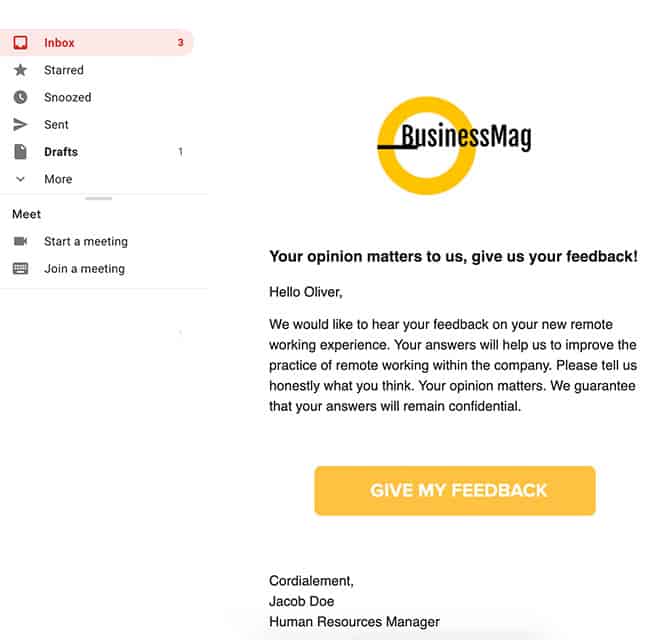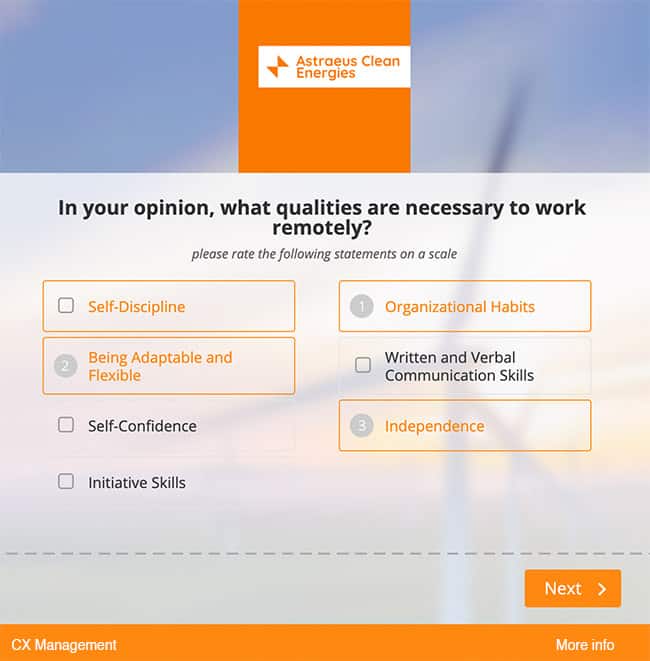As a result of the Covid-19 crisis, remote working has suddenly become widespread over the past few months and changed millions of employees’ work habits. How do your employees feel about this new way of working? What do they think? Are they satisfied? How do they perceive the advantages and disadvantages of teleworking? Your employees’...
As a result of the Covid-19 crisis, remote working has suddenly become widespread over the past few months and changed millions of employees’ work habits.
How do your employees feel about this new way of working? What do they think? Are they satisfied? How do they perceive the advantages and disadvantages of teleworking? Your employees’ wellbeing directly impacts their productivity and your customer satisfaction, so it is important to ask these questions.
Below you will find more than 20 questions to ask your employees and to include in your employee surveys.
Team satisfaction directly impacts customer satisfaction
There is a direct link between employee satisfaction and customer satisfaction. This is what the expression “symmetry of attentions” means. As shown by a Gallup study, increasing employee motivation by two points translates into a one point increase in customer satisfaction. Satisfied employees are more motivated employees!

Based on Gallup study data
In summary, by managing team satisfaction, you can reach 2 objectives:
- Improvement of employee productivity. An employee who is happy at work, and satisfied with the ways of working and management, is more productive.
- Improvement of customer satisfaction. A company who wants to take care of their customers must also take care of their employees. Which is why employee satisfaction management is an integral part of any customer satisfaction strategy.
Employee satisfaction in a remote working context
Up until a few months ago, remote working was an exception. Very few companies offered it, for a variety of reasons. The Covid-19 crisis forced a number of industries to implement remote working. Corporate culture and mindset have since evolved. Many companies have come to realise that there are advantages to this way of working, and are currently thinking about expanding, or generalising remote working.

Statistics : buffer.com
Successful remote working needs to be well organised. To put in place an efficient organisation, you need to adopt an “employee-centric” approach.
Remote working affects your employees’ daily lives, so you need to listen to their aspirations, feedback, suggestions, and measure their satisfaction. By expressing an interest in how your employees are feeling, you are also showing them know that you are listening and that their wellbeing matters. You will definitely identify areas for improvement by adopting this approach.
The questions we have listed below were designed to be part of a survey to send all your employees working remotely. This survey should be considered a tool for the continuous improvement of your management and working methods.
21 questions to ask your employees to measure their satisfaction
Before we suggest some sample questions, remember that a survey should include an introduction. The aim of this introduction is to:
- Explain your survey goals.
- Reassure your employees with a reminder that all answers will remain confidential.
Here is an example of an introduction: “We would like to hear your feedback on your new remote working experience. Your answers will help us to improve the practice of remote working within the company. Please tell us honestly what you think. Your opinion matters. We guarantee that your answers will remain confidential.”

You can invite participants to use a pseudonym. You will get more answers this way, that are more honest.
4 questions to assess an employee’s profile
What are the first questions to ask? We recommend starting with a series of questions to find out more about your anonymous employees:
- How old are you? The remote working experience may be different depending on age – younger employees tend to more at ease with the tools and technology required for remote working.
- What is your position? The remote working experience can be different from one job to the next, as certain tasks and responsibilities are better suited for teleworking than others.
- How long have you been working remotely for? This will enable you to evaluate your employees perspective.
- How many days per week are you currently working remotely? This will enable you to evaluate the expansion of remote working within your organisation.
2 questions to measure overall employee satisfaction
Next, we recommend asking one or two questions to measure your employees’ overall satisfaction with regards to remote working:
- On a scale of 0 to 5, how satisfied are you with remote working? This question allows to calculate the equivalent of the Customer Satisfaction Score (CSAT): the ESAT, Employee Satisfaction Score.
- On a scale of 0 to 10, would you recommend this way of working to colleagues? With this question, you can calculate what is known as the e-NPS. To find out more about this recommendation indicator, have a look at our guide.

12 questions to measure employee remote working experience
After measuring overall satisfaction, you can ask more specific questions about various aspects. We often recommend using this funnel logic, which consists in asking general questions at the beginning and then following up with more specific questions. Surveys built in this manner tend to generate greater respondent engagement, and therefore more answers.
Here are a few sample questions you could ask:
- Have you encountered any problems setting up remote working?
- If yes, what were they?
- Would you like to continue working remotely beyond the Covid-19 crisis? This question allows to indirectly measure your employees’ satisfaction with this way of working.
- Do you have a well-equipped and dedicated workspace at home? This is an important point. If the majority of your employees cannot set up a workspace at home, then generalising remote working could be a problem.
- Are you able to separate your work life from your personal life at home?
- How would you rate your relationship with your manager when working remotely?
- How would you rate your relationship with your colleagues when working remotely?
- How would you rate the remote working tools at your disposal (Trello, Slack, Teams, etc.)?
- Do you think remote meetings are as productive as face to face meetings?
- If no, do you have any suggestions to make them more efficient?
- If tomorrow you were to work remotely full time, do you think this change should have an impact on your salary?
- If yes, how so?
- In your opinion, what qualities are necessary to work remotely?

2 questions to evaluate the advantages or disadvantages of remote working from an employee viewpoint
There are advantages and disadvantages with remote working. It is important to know what your employees think:
- In your opinion, what are the main advantages of remote working for employees? We recommend providing a list of advantages in the answers and adding a “other” box, so that your employees can add any advantages that were not included. Some examples of advantages: a quieter work environment, saving time with less travel time, less pressure, greater autonomy, more flexibility, etc.
- In your opinion, what are the main disadvantages with remote working? We recommend proceeding in the same manner. Here a few examples of disadvantages that often come up: social isolation, less work recognition, no separation between personal and work life, a greater workload, etc.
1 question to identify areas for improvement in remote working
There are probably parts of your company’s remote working organisation that could be perfected. Especially if your company has never worked in this way before. Which is why it is useful to ask the following question:
- In your opinion, what could be improved to make remote working more appealing and efficient?

You can end the survey with an open question that will enable you to collect additional information and suggestions. For example:
- Do you have any suggestions you would like to share with us?
There are of course lots more questions that you could ask. The questions provided above can, and in some cases should, be reworded to better suit your company. But we hope that this article will prove useful and will help you build your survey. Time to collect employee feedback!








